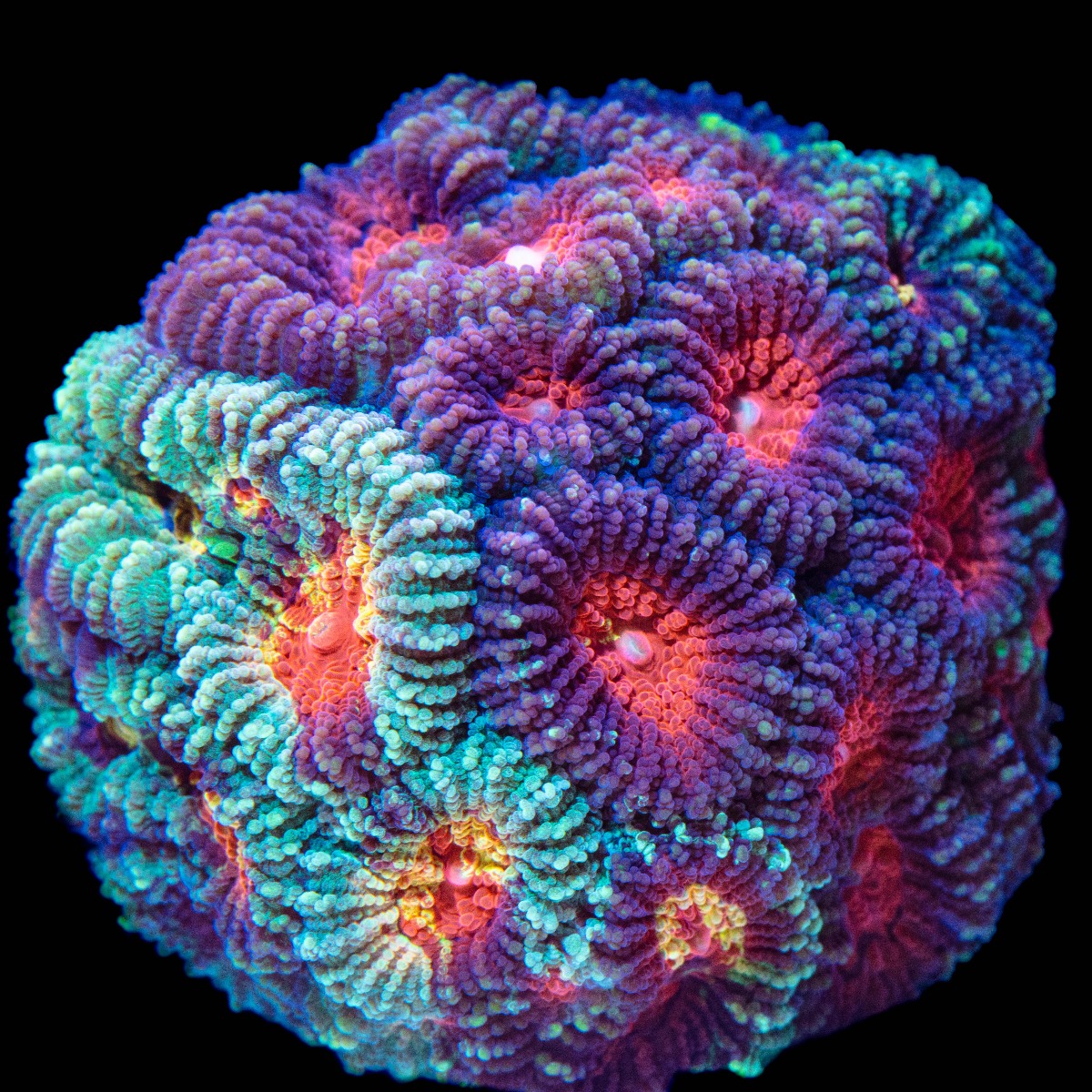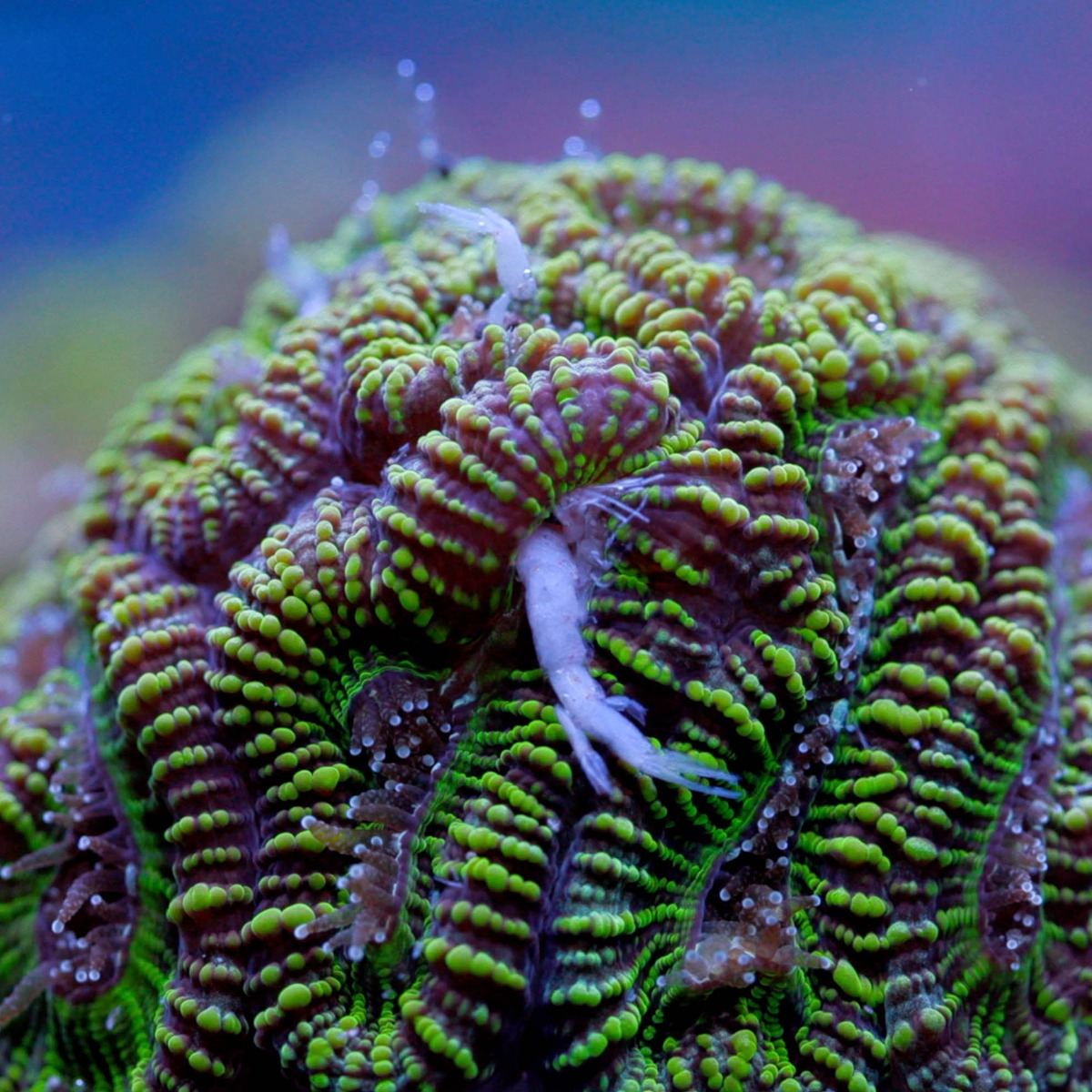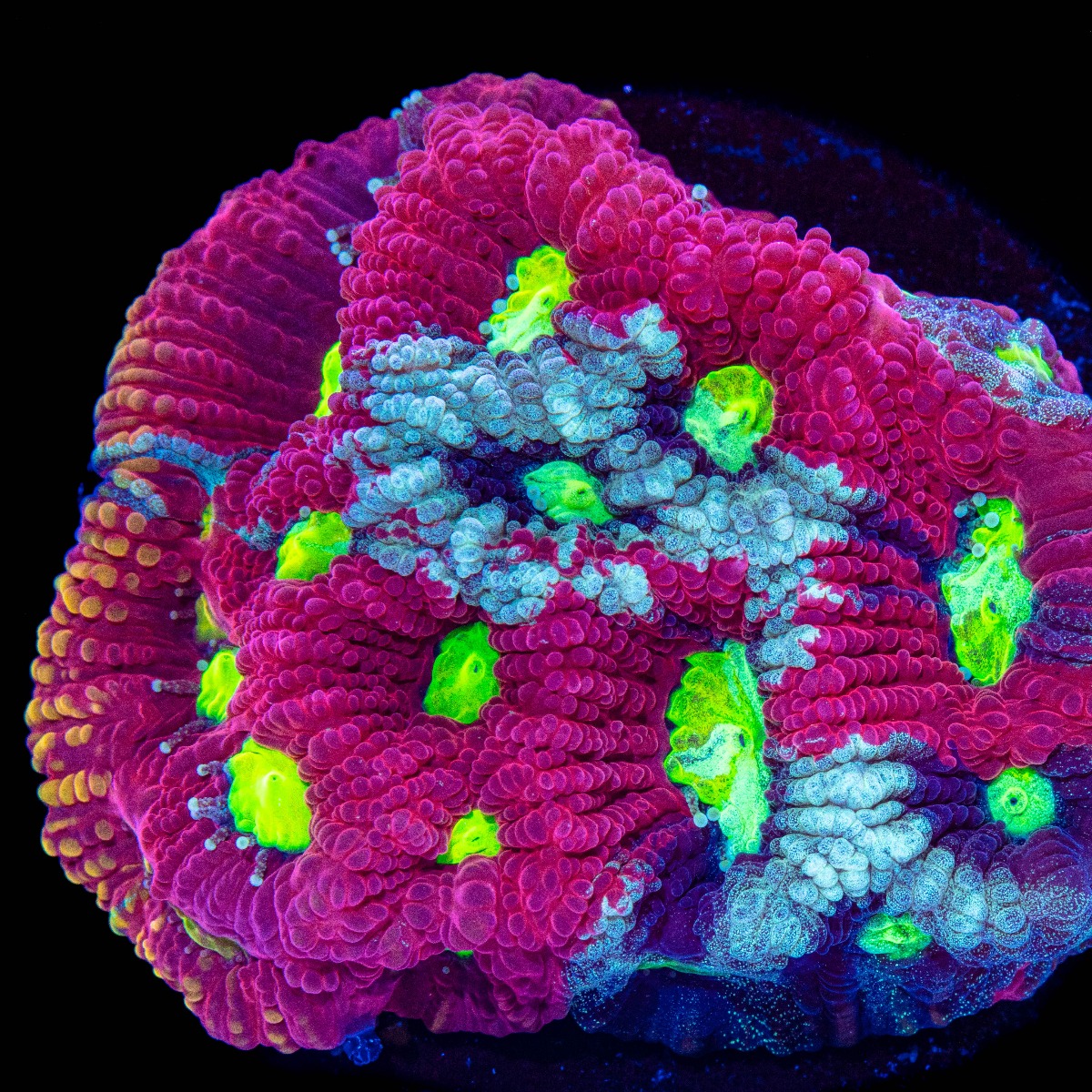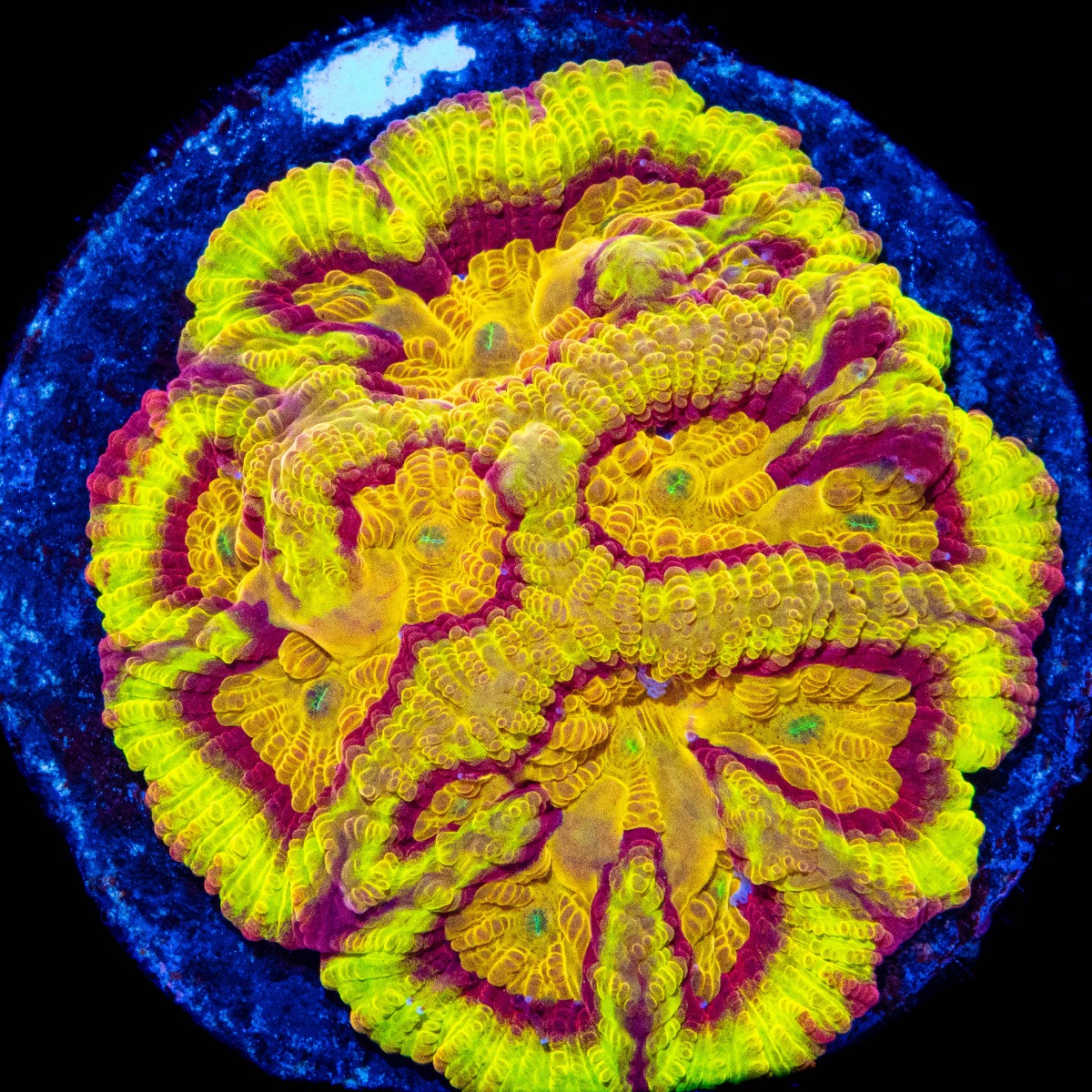Filter
My Wish List
![]() "Favia" Closed Brain Coral Care
"Favia" Closed Brain Coral Care
![]() Taxonomy
Taxonomy
What's up everyone, welcome to another Tidal Gardens coral spotlight

Freak Show Favia
Have you ever got the feeling that the term Favia covered a lot of corals that looked somewhat different? You are not alone.
Favia brain corals were one of the largest categories of large polyp stony corals in the reef aquarium hobby. At one time there were nearly 100 species of Favia but now that number dwindled down to only two, Favia fragum, and Favia gravida, both of which are Caribbean species. That means that there are essentially zero Favia brains in the reef aquarium hobby because stony corals from the Caribbean are illegal to collect. So what happened to all these species of Favia? Coral taxonomists over the years reclassified them into other genera as more information was uncovered.
Most of the corals that were once classified as Favia are now Dipsastraea, Goniastrea, Coelastrea, or Favites. So given the restructuring, why is this blog about “Favia?” In a way, the term Favia in the reef aquarium has turned into a term of art describing a group of “closed brain corals” similar to “Chalice Corals,” the difference being one is actually a scientific genus and the other is a common name. Like chalice corals, this collective of closed brain corals is ripe for misidentification especially considering many of the images online were published with either correct-at-the-time labeling or were totally misidentified from the start. It makes checking what you have in your tanks difficult.
Also, this isn’t a coral taxonomy blog, it’s a coral farming and husbandry blog, and it is more important to use the term that the community is searching for when they are looking for help with their coral.
But for you taxonomy heads, I can take a shot at ID-ing some of the more familiar closed brains. Here is where trade names helps me form a mental image of the corals. An example of a Dipsastrea would be something like a Baby’s Breath “Favia” or a Meltdown “Favia.” Some of the larger polyp corals that were once favia, like Dragon Souls or Reverse Prisms, are now Coelastrea. The small polyp, fast growing, corals are still Favites but a lot of the corals that we had previously lumped in as Favites are actually other things entirely, such as Platygyra.
So there has been quite a lot of shuffling, but hopefully you achieve some sort of mental image of what I'm talking about. Naming conventions aside, let's get into the husbandry side of things.
![]() Lighting
Lighting
When it comes to lighting Favia corals are not too demanding and can be grown successfully under a wide range of lighting conditions. Favia are photosynthetic corals, meaning they get nutrients from the products of photosynthesis that is carried out by symbiotic dinoflagellates called zooxanthellae living in their flesh. Zooxanthellae utilize chlorophyll to absorb light and produce simple sugars that the coral can consume for energy. The corals can regulate the amount of zooxanthellae present in their bodies by occasionally expelling excess zooxanthellae that looks like a stream of brown slime coming out of the polyp. This regulation of zooxanthellae can impact the coloration of the coral. In the extreme, total expulsion of zooxanthellae leads to bleaching.
We primarily keep Favia in low to medium light intensity here at Tidal Gardens which is around 50 to 100 PAR. We have kept them in higher lighting but they did not appear to appreciate it and were always at risk of bleaching out. If you have a colony of Favia and want to experiment with higher light, remember that it can be a risk, so be prepared to move it into a shadier region of the tank at the first signs of trouble. Remember that a coral can live for a long time in lighting conditions that are too dim, but they will not last long in lighting conditions that are too bright.
As for how the lighting spectrum affects their coloration, most Favia stay pretty consistent and are not likely to change color dramatically with changes in lighting spectrum. You may see a subtle change comparing a specimen grown primarily under daylight vs blues however it won’t completely swap out an entire color palate like some corals are capable of. Because there are so many corals under this collective Favia umbrella, some may be very fluorescent which is a joy to look at under full actinic light. Others might have very little fluorescence and look great in daylight, for example this reverse prism Coelastrea.
Low Light


Lighting is a loaded topic, so for a more in-depth discussion of lighting, please see our Deep Dive article.
![]() Feeding
Feeding

Favia Feeding on Mysis
Moving onto feeding, this is probably the most underrated aspect of their care. As we discussed earlier, Favia are photosynthetic and can survive on light alone. There are plenty of hobbyists that make no effort to spot feed their corals that are able to keep Favia long-term. Having said that, the difference between a Favia that is regularly fed and one that is not is night and day. A fed Favia looks a lot fleshier and the growth rate is greatly accelerated.
As far as what to feed and how to feed, what I like to do is lightly feed the tank in advance. This does two things for us. First, it fills up their bellies making it less likely they will try to steal food from the corals. Second, the food in the water activates the coral’s feeding response making it easier to spot feed. Some varieties of Favia can take a few minutes to initiate their feeding response.
If you can feed them 3 times per week a mix of powdered plankton and frozen mysis shrimp, you will see a dramatic increase in size and growth rate. Some are already fast growing such as Favites however there are some notoriously slow growing varieties like Goniastrea that go from arguably the slowest growing coral to something that can be farmed with a little patience. Much of what makes these corals “slow growers” is lack of food and when provided with lots of direct feeding they take off.
The reason that I recommend only 3 days a week starting out is to give the corals an opportunity to expel waste when they are done digesting. Sometimes piling food on corals like this goes great at first but then goes south when the food isn’t properly expelled and the food starts to rot. Three days a week is plenty.

![]() Flow
Flow
There are some that consider water flow more important to coral health than any other parameter. It may be true in some cases, but I think that it is less of a factor in Favia health compared to other corals. Favia are tolerant to a wide range of flow patterns and adjusting flow specifically for Favia may be fruitless. I like to try and provide a very middle-of-the-road low to medium flow. Too little flow and you run the risk of allowing detritus to settle on the colonies which creates dead spots. Too much flow and you run the risk of damaging the coral. You will know if you are overdoing it if the flow is slamming one side of the coral and it is drawn tight to the skeleton all the time.
For feeding purposes I like being able to shut off all the flow for about 20-30 min to allow the colony to react to the food and consume it. Even a small amount of flow during spot feeding sessions can waste a lot of food.

![]() Placement
Placement
Growth forms vary from massive dome shapes to encrusting growth forms. Tough to tell what they are going to be starting from frags.
As for placement, almost every tank I see these corals in keeps them at the bottom of the tank regardless of whether it has a substrate or bare bottom. They settle in nicely down there are when they are happy will extend nicely and take on that Chili’s lava cake appearance. I suppose there isn’t a good reason that they couldn’t be put up on a rock scape, but it is much less common. Perhaps the thinking is that higher up on the rock scape would expose the coral to more light and more flow which might not be the best combination for this coral.
One other thing about placement to consider is to consider how much it will spread out once it settles into your reef tank. Favites encrusts, most others will take on a dome shape.
![]() Chemistry
Chemistry
Let’s talk briefly about water chemistry. Favia brain corals are stony corals and as such, they require consistent levels of calcium, alkalinity, and to a lesser degree magnesium in order to grow their skeleton. People often ask what the levels for specific corals should be and I always say to stick with something close to natural sea water levels with an emphasis on consistency over specific values. I would go as far as saying it is better to keep suboptimal levels of calcium, alkalinity, and magnesium consistent rather than trying to fix low levels overnight with additives.
Calcium is one of the major ions in saltwater. In the ocean, its level hovers around 425 parts per million. As a coral grows calcium is absorbed from the water and used to forms its calcium carbonate skeleton.

Scarlet Favites
Alkalinity a collection of ions that generally equate to carbonate availability in the water. The official definition is that it is the amount of acid required to lower the pH of saltwater to the point bicarbonate turns into carbonic acid. If you have more alkalinity, it can soak up more acid. Less alkalinity and you have less buffering capacity making the tank more susceptible to chemical changes.
In practice alkalinity tends to be the parameter that fluctuates the most. In natural sea water, the alkalinity of the water measures around 7 or 8 dkh though most salt mixes these days mix up closer to 8 to 9 dkh. Some aquarists like to overload this parameter a little and keep their tanks around 10 or 11 dkh with the rationale that having elevated calcium and alkalinity in the water contributes to faster stony coral growth.
If you are experiencing low levels, say for example, low alkalinity, you can add a supplement to boost it, but first double check your test results (and test kit) to make sure you are actually experiencing low levels, and then make the change slowly over the course of weeks until you reach a level more in line with natural sea water levels.
To maintain consistent levels, the amount of supplementation will depend a lot on the size and growth rate of the stony corals in your tank. There are some corals like Coelastrea that are pretty slow growing and do not soak up tons of major elements. On the other hand, fast growing corals like Favites might be more demanding on your reef’s chemistry. On average, a typical reef aquarium focusing mainly on slow growing LPS might get away with doing water changes to replenish major and minor elements, but it is always a good idea to periodically test to make sure your levels are not all out of control.
If you are having trouble maintaining calcium and alkalinity, keeping an eye on Magnesium can help. Raising both calcium and alkalinity together can be tricky because of how they interact. Calcium ions and carbonate want to react with one another. Addition of a calcium supplements often comes with a corresponding fall in alkalinity levels and vice versa. If you are experiencing this in your systems, it is normal by the very nature of those ions but it is something you want to try and minimize. If you are experiencing dramatic swings of calcium and alkalinity every time you use an additive, you may want to look at your Magnesium levels. In short, Magnesium acts to increase the overall bioavailability of alkalinity compounds in the water thus providing more chemical stability. In the ocean, Magnesium sits at about 1350 ppm.
Calcium and alkalinity aside, stony corals are sometimes more sensitive to declining water quality. In particular, pay attention to elevated nitrate levels. Low nitrate levels around 5-10ppm are actually welcome for large polyp stony corals, but around 30-40ppm of nitrate you might start running into some issues. If I see a coral suddenly start receding my mind immediately goes to possible nitrate issues. To remedy elevated nitrates I look to up nutrient removal through more aggressive protein skimming, detritus removal, and more frequent water changes. You could try to limit nutrient input by cutting back on feeding, but I tend to favor heavier feeding and dealing with the possible overages than underfeeding because on average I think that most aquariums are not getting enough food. That is just me though, so it is something you will have to experiment with in your own system.
That should give you a little bit of background on the chemical parameters to keep an eye on.
![]() Aquaculture
Aquaculture
Aquaculture prospects for Favia are going to vary on a Genus to Genus basis. This is one aspect where lumping them all into one category doesn’t quite work out so well. Some varieties like Favites grow incredibly fast. Other varieties like Coelastrea are one of the slowest. That is the major hurdle with long term aquaculture - the growth rate of these corals. They can be cut pretty easily and heal well from cutting across the board but some might not be the best candidates for long term commercial aquaculture.

Scorpion King Favia
For home hobbyists? Sure go nuts, but to commercially farm the super slow growing ones, it will either require a major allocation of space or new techniques to enhance their growth rate. Feeding and nutrition is one main thing but more might have to be done.
![]() Pests
Pests
Pests for Favia are thankfully uncommon. You are much more likely to have a bad interaction from a tang or fox face getting too nibbly or a cleaner shrimp or hermit crab climbing all over this coral trying to get to food. The one pest I have seen before is a flatworm that can show up on a lot of different kinds of large polyp stony corals. They are usually beige in color and show up on elegances, scroll corals, pectinia, Acanthophyllia, and you guessed it, these Favia-type brains too. They are not particularly fast reproducing and do not seem to cause much damage. They are also very easy to dip which is why I don’t get kept up at night worrying about them. Still, I did want to cover it just in case you happen to see them on one of your other LPS. A quick dip will do the trick.
![]() Conclusion
Conclusion
So what kind of tank do I think Favia would look great in? I view Favia as a staple LPS in a mixed reef. There are plenty of absolute show stoppers but I think their strength aesthetically is that they kind of ground things and let other corals shine. Sometimes when there are too many rockstar pieces things can look distracting. It is times like that where support pieces like these brain corals can really help balance things out and provide a sense of visual depth. They might not be the first thing people notice in the tank but rather something to be discovered. What do you guys think?
Until next time, happy reefing!
